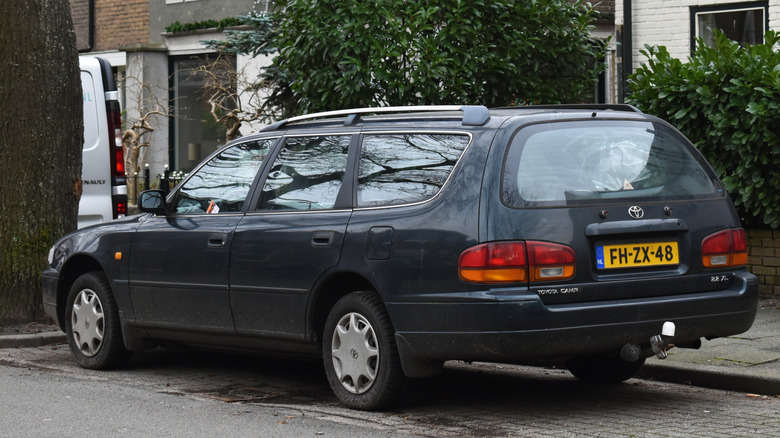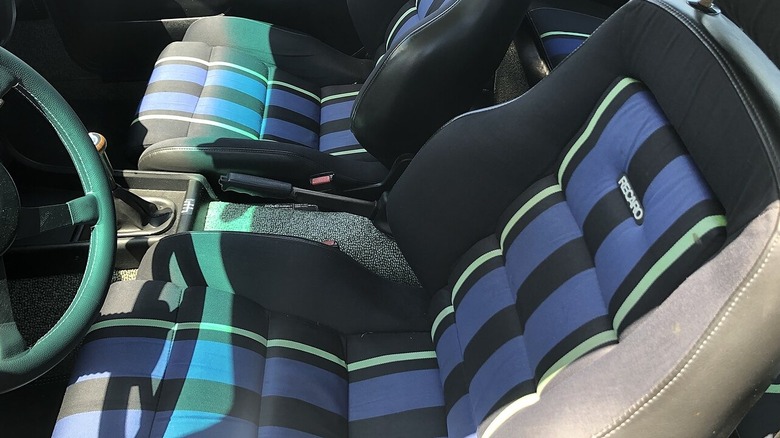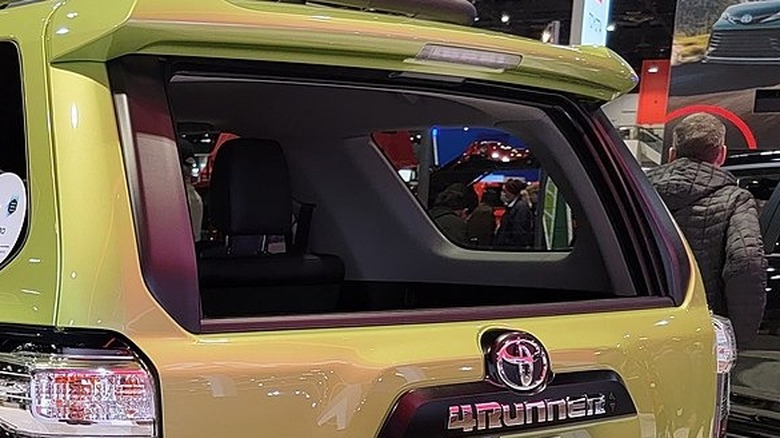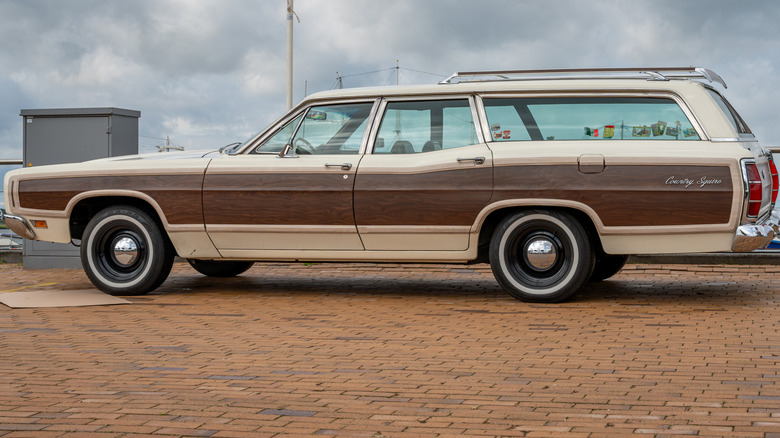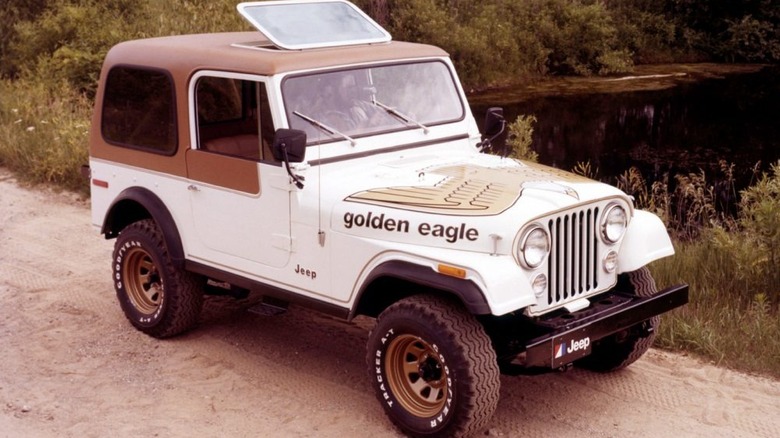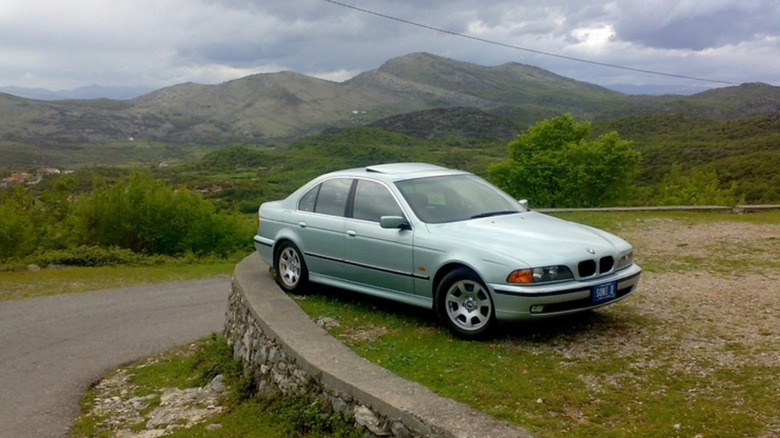5 Old-School Car Trends That Need To Make A Comeback
If you think modern cars are boring, you are not alone. The always colorful Reddit community is happy to share, in no uncertain terms, that today's automotive offerings stink. A common complaint centers around safety innovations removing the "feel" of a car. Then there is the crossover, a vehicle type that anyone can see has inundated American roadways. These vehicles often share a remarkably similar profile that can increase the sense of boringness.
A sentiment that is further amplified by the simultaneous decrease of once-familiar automotive segments like the sedan, station wagon, convertible, and sports car that offered design variety. Ramming the blandness of this vehicular homogeneity home is that 80% of all cars sold in the Americas come finished in some version of black, gray, silver, or white paint. That's a lot of boring cars on the road, which is a problem perhaps no one outside the enthusiast community is asking to be fixed.
But for those who prize cars with personality, vehicles with verve, and just the general excitement of a cool car, there is a solution. Well, many solutions. Specifically, five old-school automotive trends that could reverse this movement toward sameness. Trends that thumb their nose at dull paint jobs, disconnected driving experiences, and a lack of variety. These old-school car vibes could be the antidote to our modern problem of an uninspired automotive industry.
Patterned cloth seats
Heck, forget the patterns, how about just plain old cloth seats? Not the cheap mouse fur fabric found in the likes of a stripped-out F-150, but the textured finesse of a fine Tartan. In fairness, the cloth seat is not entirely extinct. Volkswagen keeps the flame burning for mass-produced cars that offer excellent seat style with the GTI's Clark plaid. Volvo is another fan of this approach, as evidenced by the Tailored Wool option on its XC90 SUV.
But outside that, you're getting into high-dollar rarities like the Porsche 911 Sport Classic and its Pepita look. The far more common approach to modern car interiors is real leather or a synthetic version, usually ending in "Tex". Subaru has StarTex, Kia has SynTex, and Mercedes has MB-Tex. Not only are we leaning back into the slippery slope of sameness, these materials can be hard and frigid in the winter or blazing hot in the summer. The obvious solution is old-school patterned cloth seats.
Porsche once offered a wacky Pasha pattern on its 928. Recaro was renowned for zany seats like those in the Mk3 VW GTI or the classic single-stripe units found in so many of Alpina's BMW beauties. The Recaro Tomcat, with a sharp yellow and black pattern, embroidered branding, and manually inflatable lumbar support bladders, was in a whole different league.
Roll-down rear windows
Rear windows that retract into a vehicle's tailgate are now almost exclusively found in Toyotas. The 4Runner, in particular, is famed for this feature and is an SUV you may have seen driving along with a dog looking at you through the open rear window. Toyota almost didn't keep this trend alive for the all-new 4Runner due to concerns with weight and automatic tailgate operation, but it thankfully relented and also continues to offer this feature on certain Tundra models.
To be clear, we're not talking about flip-up rear glass, like you can find on the Lexus GX and Ford Bronco Sport. Rivian also looks to be joining Toyota with its upcoming R2 SUV, but that's about it for the modern lineup. However, a dig through old brochures reveals a wide range of cool old school cars with this feature. Station wagons from the '80s, like the Buick my mom drove back in the day, came with roll-down rear windows.
Ford Broncos from the 90s were another adopter, along with the seventh-generation Chevy Suburban. The tiny Honda Civic Del Sol did the roll-down trick, and the oddball GMC Envoy XUV could retract both the back glass and the rear section of its roof. Along with adding cargo flexibility for long items, the roll-down rear window adds flow-through ventilation, seems to make dogs happy, and just looks cool. It is due a comeback.
Station wagons
I will never understand why Americans consistently go for crossovers instead of station wagons, but there's no denying it is a dying breed. As of 2025, fans of the long roof form have just a single mainstream option in the Subaru Outback, and for 2026, this mainstay of the wagon segment has clearly been pushed into the crossover lane. Mercedes and Volvo continue to offer — for now — wagon versions of their sedans, but only with plastic body cladding to add some sort of off-road aspect.
If those are too pricey for the average buyer, then forget about the wickedly powerful BMW M5 Touring and Audi RS6 Avant that are effectively supercars in wagon camouflage, with the massive output and six-figure price tags to prove it. This is a shame as wagons offer a profile that is, arguably, sleeker and more visually interesting than the typical blob-shaped crossover. And it wasn't always like this. Truly old-school American cars from the 1950s and '60s offered a station wagon for seemingly every single model.
More recent wagon varieties included the Toyota Camry, Cadillac CTS, Ford Taurus, and Dodge Magnum. Then there are five-door rare birds like the Toyota Tercel, Lexus IS300 SportCross, and Mitsubishi Lancer Sportback. All of which brought the sort of chutzpah and carefree approach to vehicle design sorely lacking in today's crop of crossovers.
Body graphics
On the topic of chutzpah, can we reflect on the 1970s glory days of SUV design and graphics? Jeep spread its Golden Eagle brand of visual excitement across many vehicles, like the J10 with its huge gold-colored eagle on the hood and sweeping color-coordinated body stripes. And let us not forget Daisy Duke, from The Dukes of Hazzard, and her CJ-7 of similar style. Scout went relatively subdued with its Rallye styling package, featuring broad, white body graphics that swept up onto the hood.
Or how about Ford's Pinto in "Cruising Wagon" guise, replete with bright tri-color stripes that wrapped all the way around. For fans of less garish looks, recall BMW's 1995 M3 Lightweight and its multi-colored checkered flag motif. All of these examples are the antithesis of an automotive landscape dominated by hues of white, black, and gray. Ford has certainly kept the old-school graphics fun alive with the Free Wheeling package on the Bronco Sport and its big brother Bronco, both of which feature a sunset-style gradient of yellow, orange, and red.
Not to mention the Raptor R with its massive letter R set on a stack of horizontal lines. Jaguar went wild with its XE SV Project 8 that had a giant leaping cat coming across the rear quarter panel, Project 8 logos, and a full-length stripe. But, generally speaking, body graphics are few and far between these days. A comeback tour of this old-school trend would bring some much-needed vitality to a mostly gray present-day lineup.
Analog cars
The modern automobile is a technological powerhouse, stuffed with huge touchscreens, ultra-bright headlights, and slick powertrains. Certainly, high-tech cars are more convenient from a connectivity perspective, come with objectively safer features than in years past, and are more fuel-efficient than before. However, the old-school approach of analog cars is worth considering when you look at the flip side of this tech-focused coin. Doing away with touchscreen displays would not only remove the distraction of having an oversized version of your smartphone front and center, it would force drivers to drive.
As in, figure out how to get from Point A to Point B on their own and pay attention to something besides text messages and YouTube, while driving. Crisp LED headlights are nice when driving at night, but should you need to replace one, prepare to shell out the big bucks. A single Hyundai Ioniq 5 headlight runs more than $2,000 to have fixed by a dealership, for example. There was a time when you could simply swap out a blown headlight bulb for a few dollars.
The new Stellantis line of Hurricane engines make huge amounts of power, but don't have an oil dipstick. Instead, you rely on an electronic sensor to keep an eye on oil levels, which feels like an expensive, overcomplicated "upgrade" versus simply popping the hood to check the oil. As for modern transmissions, bring back the three-pedal manual variety to at least offer drivers an opportunity to be more engaged behind the wheel.
